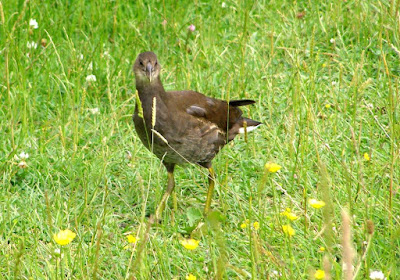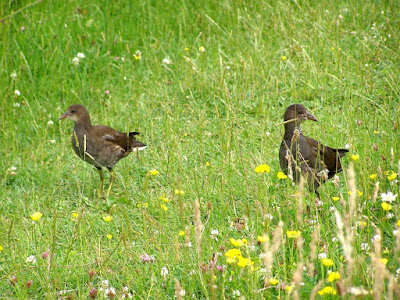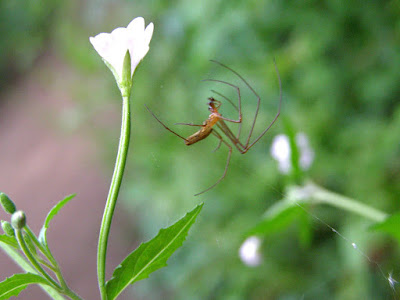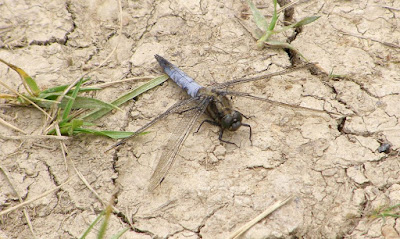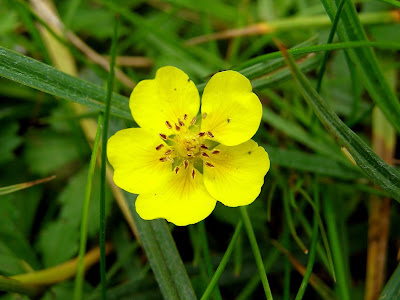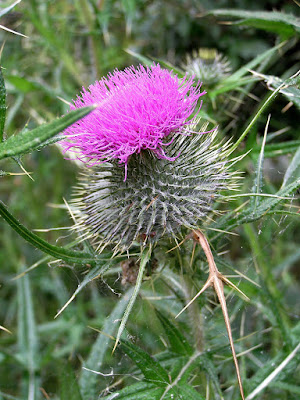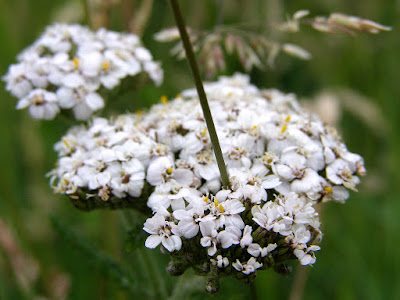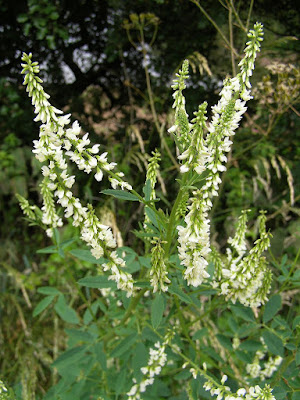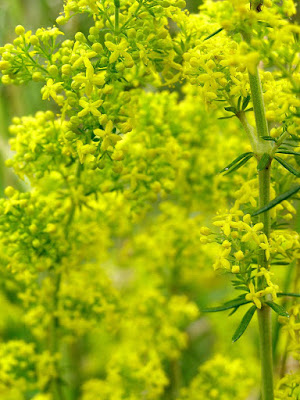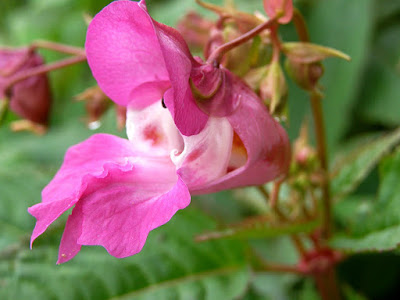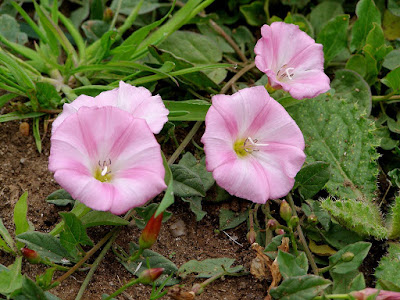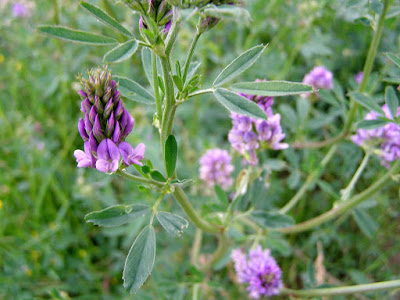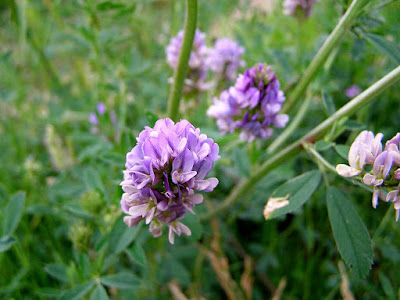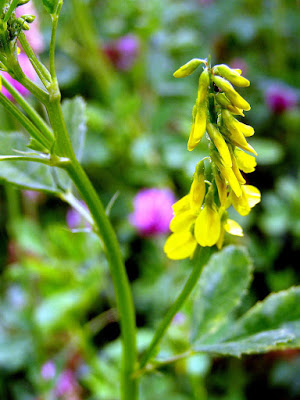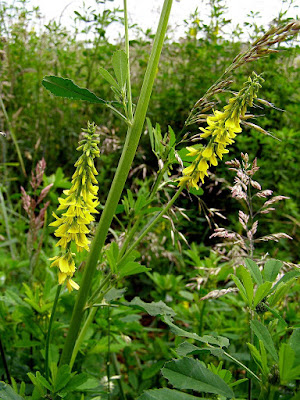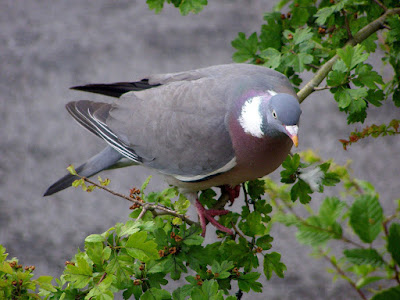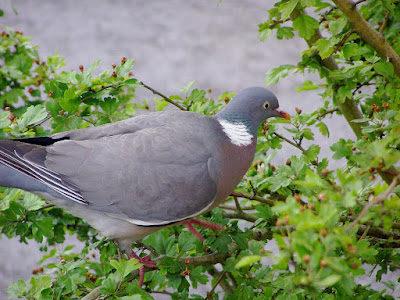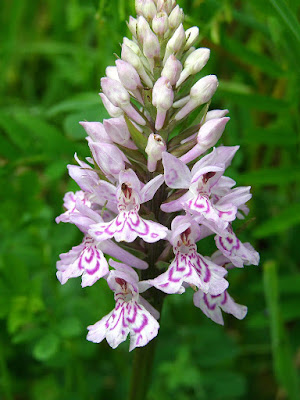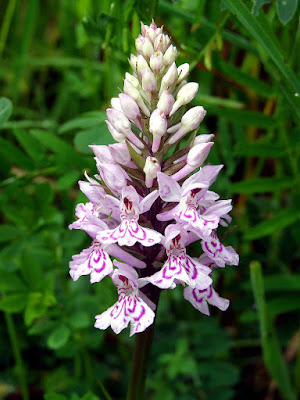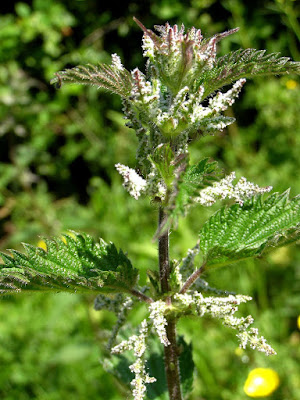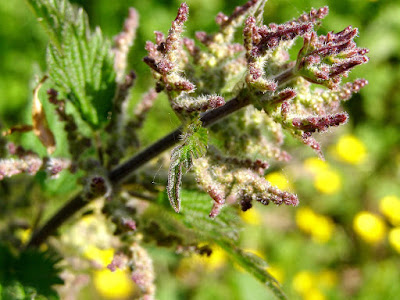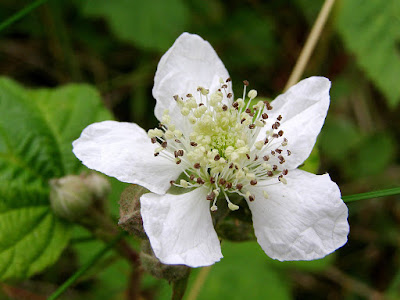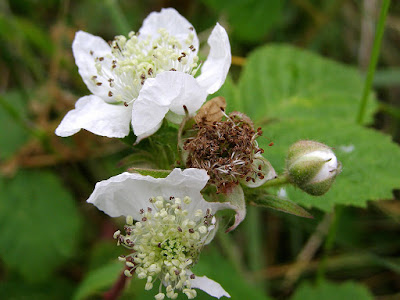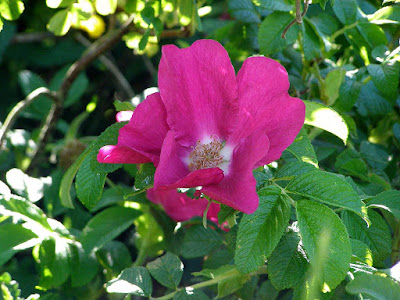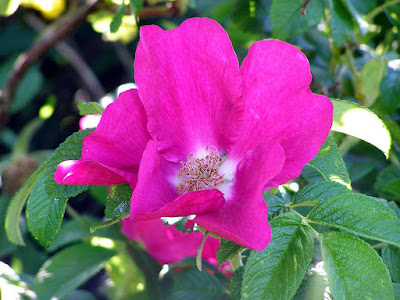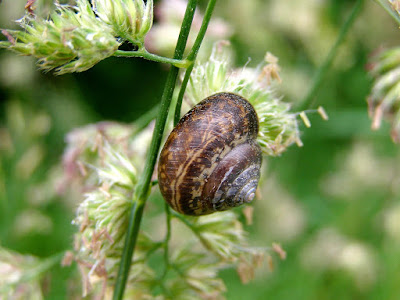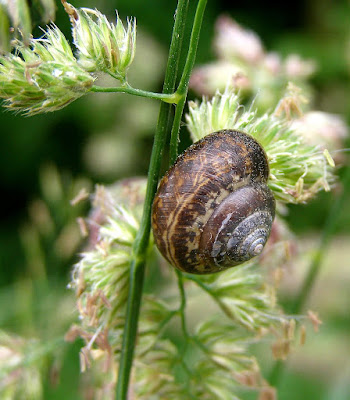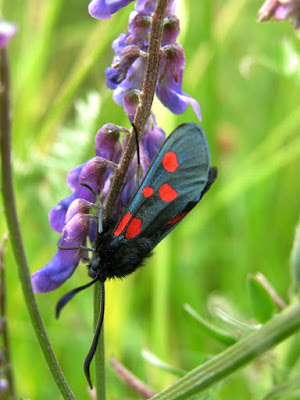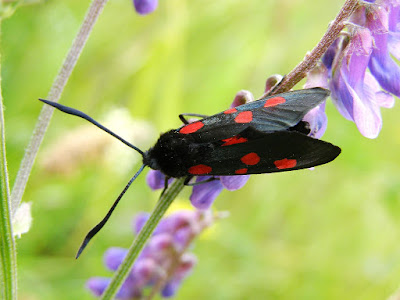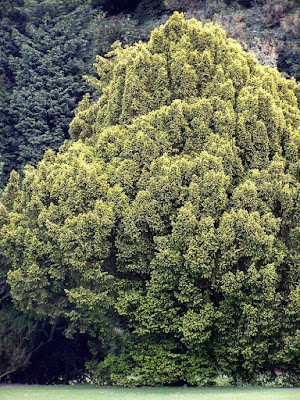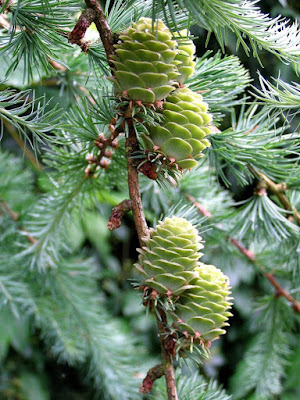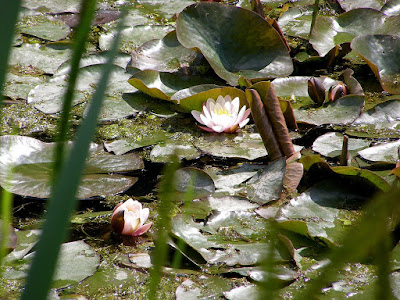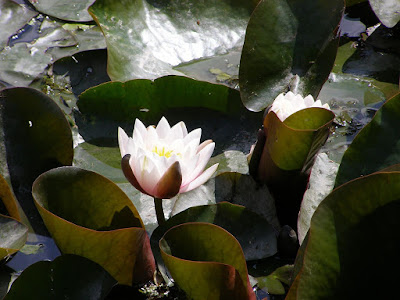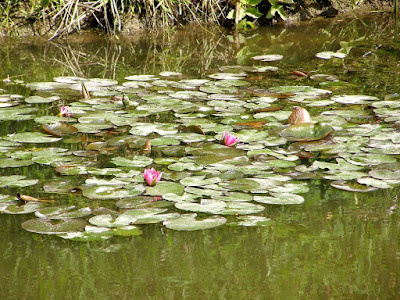This morning was extremely hot and humid as Malcolm and I took a short-ish walk around the park. as we were walking round one of the Straw's Bridge ponds, I noticed that we were being followed....
These two juvenile Moorhens (Gallinula chloropus chloropus) seemed to be very interested in us as they picked their way through the water-side meadow.
Moorhens belong to the Genus Gallinula, members of the Rail (Rallus) family of birds. Gallinules are found almost world wide and the genus includes some of the most critically endangered species of birds in the world. thankfully, these Common Moorhens are far from endangered. Well known to us all, they are usually very shy of humans, but these youngsters do not yet seem to have inherited this particular trait.
Welcome to my blog. Don't expect anything too high-tech or flashy, this is simply a 'diary' to share some of my photos, thoughts and observations - with a particular bias towards the natural world and the countryside around my home.
Tuesday 30 June 2009
Monday 29 June 2009
Turn into what?
Along the paths around one of the Straw's Bridge ponds, was a silken tent attached to the stinging nettles. From within the tent was spilling forth a large number of strange-looking grubs with spiky growths along their backs. They belong to the Caterpillar of the Peacock Butterfly (Inachis io).
Looking at these odd little creatures, it is difficult to think that, all being well, they will eventually turn into one of the most beautiful insects to grace the British skies. Seen here in a photo by Nick Woolley.
Looking at these odd little creatures, it is difficult to think that, all being well, they will eventually turn into one of the most beautiful insects to grace the British skies. Seen here in a photo by Nick Woolley.
Sunday 28 June 2009
Dandelion and ?
An imposing plant to kick off today's blog entry. Growing all around the highways and byways of Shipley Park are these stately, tall, large-leaved plants. Great Burdock (Arctium lappa).
The flowers are not quite open yet, they will take another few days, but the size of the leaves - up to 3ft long and 2ft wide - is impressive enough. The whole plant grows to more than 6ft tall and, when the flowers start to appear, they look a little like thistle heads. The round flower heads are made of masses of stiff bracts, each with hooks (or burs) on the end and it is from these that it gets it's name. Great Burdock was used as a vegetable during the middle ages, but only a few countries of the world still eat the roots, notably some of the Far-Eastern countries. It was also used for traditional Dandelion and Burdock soft drink. The roots of both plants being fermented together to make a naturally sparkling drink. Like most things these days, modern-day Dandelion and Burdock actually contains not a trace of either plant, relying on artificial flavours instead.
The flowers are not quite open yet, they will take another few days, but the size of the leaves - up to 3ft long and 2ft wide - is impressive enough. The whole plant grows to more than 6ft tall and, when the flowers start to appear, they look a little like thistle heads. The round flower heads are made of masses of stiff bracts, each with hooks (or burs) on the end and it is from these that it gets it's name. Great Burdock was used as a vegetable during the middle ages, but only a few countries of the world still eat the roots, notably some of the Far-Eastern countries. It was also used for traditional Dandelion and Burdock soft drink. The roots of both plants being fermented together to make a naturally sparkling drink. Like most things these days, modern-day Dandelion and Burdock actually contains not a trace of either plant, relying on artificial flavours instead.
Saturday 27 June 2009
Two New Flowers.
This morning's walk was not very long as it was so humid and 'sticky', but we found two plants which I hadn't photographed before. Firstly was the Black or Common Knapweed. A member of the Daisey family, it is also known as the Lesser Knapweed (Centaurea nigra)
Looking rather like other members of the Centaurea genus including Cornflowers, it is a familiar flower of the British hedgerow.
Secondly is the Woody Nightshade (Solanum dulcamara). This plant has many different common names including bittersweet, bittersweet nightshade, bitter nightshade, blue bindweed, climbing nightshade, fellenwort, felonwood, poisonberry, poisonflower, scarlet berry, snakeberry, trailing bittersweet, trailing nightshade, violet bloom. Quite a list.
Most of us know it from our childhood as 'Deadly Nightshade', everyone's parents warned their children off it with tales of illness and death. True Deadly Nightshade is, however something very different. Bittersweet is a member of the Solanaceae family which includes Potatoes, Tomatoes, Aubergines and Peppers. The berries of the Bittersweet are poisonous, as are the leaves, but the flowers are very beautiful as the petals curl back to reveal the conical column of stamens.
Looking rather like other members of the Centaurea genus including Cornflowers, it is a familiar flower of the British hedgerow.
Secondly is the Woody Nightshade (Solanum dulcamara). This plant has many different common names including bittersweet, bittersweet nightshade, bitter nightshade, blue bindweed, climbing nightshade, fellenwort, felonwood, poisonberry, poisonflower, scarlet berry, snakeberry, trailing bittersweet, trailing nightshade, violet bloom. Quite a list.
Most of us know it from our childhood as 'Deadly Nightshade', everyone's parents warned their children off it with tales of illness and death. True Deadly Nightshade is, however something very different. Bittersweet is a member of the Solanaceae family which includes Potatoes, Tomatoes, Aubergines and Peppers. The berries of the Bittersweet are poisonous, as are the leaves, but the flowers are very beautiful as the petals curl back to reveal the conical column of stamens.
Friday 26 June 2009
Careful!
A lovely walk this morning through Shipley Park, round Mapperley Reservoir and back home. We caught sight of some spectacular invertebrates today - spectacular to us, but not if you are on their menu!
Firstly one of our eight-legged 'friends' which goes by the name of a Long-jawed Spider (Tetragnatha extensa).
The long body of this little charmer can vary in colour and it sits in it's web (here, attached to a Willowherb) waiting for some unfortunate insect to stumble in. Harmless to humans, it is deadly to moths, flies and mosquitoes.
Next is a rather more handsome creature, the Black-tailed Skimmer (Orthetrum cancellatum).
Found near standing water and rivers with muddy banks such as where cattle have trampled the ground into soft mud. When hunting, they skim over the water, close to the surface. They often clash with other males where their territories meet. This species is not common but, thankfully on the increase.
Firstly one of our eight-legged 'friends' which goes by the name of a Long-jawed Spider (Tetragnatha extensa).
The long body of this little charmer can vary in colour and it sits in it's web (here, attached to a Willowherb) waiting for some unfortunate insect to stumble in. Harmless to humans, it is deadly to moths, flies and mosquitoes.
Next is a rather more handsome creature, the Black-tailed Skimmer (Orthetrum cancellatum).
Found near standing water and rivers with muddy banks such as where cattle have trampled the ground into soft mud. When hunting, they skim over the water, close to the surface. They often clash with other males where their territories meet. This species is not common but, thankfully on the increase.
Thursday 25 June 2009
Scotch Mist?
No. Yorkshire Fog! A strange name for one of our more common grasses. Standing a good 2ft tall or more, Yorkshire Fog (Holcus lanatus) has soft, feathery flower heads and soft, grey-green leaves which may be the origin of it's name.
Seen almost anywhere there is grassland, highways and byways, this is a lovely, architectural plant and a useful one too. The plant itself is the main food plant of Speckled Wood Butterflies and many species of Skippers. The seeds are a favourite of many small finches and mammals. The seeds are produced prolifically each flower head or panicle, may produce up to 380 seeds.
Seen almost anywhere there is grassland, highways and byways, this is a lovely, architectural plant and a useful one too. The plant itself is the main food plant of Speckled Wood Butterflies and many species of Skippers. The seeds are a favourite of many small finches and mammals. The seeds are produced prolifically each flower head or panicle, may produce up to 380 seeds.
Wednesday 24 June 2009
Creeping things
Not insects or other creepy - crawlies, but creeping plants. First 'cab-off-the-rank' is the Creeping Cinquefoil (Potentilla reptans).
A very low-growing plant with the most glorious yellow flowers. Another part of the Rosaceae family and therefore a cousin of the roses, brambles, etc. Also a great favourite with many butterfly species, especially the 'Skippers'.
Secondly, we return to the Thistles and the Daisy family. This time a Creeping Thistle. (Cirsium arvense)
As the name suggests it spreads by means of a 'creeping' root system which sends up shoots from along it's length. The stems are not very strong and unless supported by surrounding foliage, they can spend much of the time prostrate and laying along the ground. The flowers are loved by many insects, especially the butterflies. Goldfinches make a great feast of them when they seed.
A very low-growing plant with the most glorious yellow flowers. Another part of the Rosaceae family and therefore a cousin of the roses, brambles, etc. Also a great favourite with many butterfly species, especially the 'Skippers'.
Secondly, we return to the Thistles and the Daisy family. This time a Creeping Thistle. (Cirsium arvense)
As the name suggests it spreads by means of a 'creeping' root system which sends up shoots from along it's length. The stems are not very strong and unless supported by surrounding foliage, they can spend much of the time prostrate and laying along the ground. The flowers are loved by many insects, especially the butterflies. Goldfinches make a great feast of them when they seed.
Tuesday 23 June 2009
Attenborough Flora
Continuing on yesterday's theme of Attenborough Nature Reserve, some more floral delights from our walk. Firstly, a familiar if rather spiky friend, a thistle. In this case a Spear Thistle (Cirsium vulgare).
A member of the family Asteraceae and as such a cousin of the daisies, the Spear Thistle is named by DEFRA as an 'injurious weed' requiring the occupier of the land on which it grows, to take immediate action to prevent it's spreading! Such a pity when it is such a useful flower for all types of insect.
Next the Yarrow (Achillea millefolium)
Also known as Gordaldo, Nosebleed plant, Old Man's Pepper, Sanguinary, Milfoil, Soldier's Woundwort, Thousand-leaf and Thousand-seal. The 'Thousand' of those last two names referring to the scientific name of millefolium. It is a very useful plant in medicine as an aid to healing wounds and abrasions. Achilles is supposed to have carried this plant into battle for just such these reasons - hence the Scientific name Achillea!
One plant you may not be so familiar with is this small, greenish flowered climbing perennial, the White Bryony (Bryonia alba)
The Royal Navy have named two ships HMS Bryony after this plant see HERE and HERE
Lastly, do you remember the Tall Melilot I mentioned a few days ago? Well, a cousin of that 'pea' plant is the White Melilot (Melilotus albus).
Again a useful forage plant and nitrogen 'fixer'.
A member of the family Asteraceae and as such a cousin of the daisies, the Spear Thistle is named by DEFRA as an 'injurious weed' requiring the occupier of the land on which it grows, to take immediate action to prevent it's spreading! Such a pity when it is such a useful flower for all types of insect.
Next the Yarrow (Achillea millefolium)
Also known as Gordaldo, Nosebleed plant, Old Man's Pepper, Sanguinary, Milfoil, Soldier's Woundwort, Thousand-leaf and Thousand-seal. The 'Thousand' of those last two names referring to the scientific name of millefolium. It is a very useful plant in medicine as an aid to healing wounds and abrasions. Achilles is supposed to have carried this plant into battle for just such these reasons - hence the Scientific name Achillea!
One plant you may not be so familiar with is this small, greenish flowered climbing perennial, the White Bryony (Bryonia alba)
The Royal Navy have named two ships HMS Bryony after this plant see HERE and HERE
Lastly, do you remember the Tall Melilot I mentioned a few days ago? Well, a cousin of that 'pea' plant is the White Melilot (Melilotus albus).
Again a useful forage plant and nitrogen 'fixer'.
Monday 22 June 2009
Attenborough Reserve
A lovely walk this morning around the Attenborough Nature Reserve and along a bit of the River Trent. There were many wild flowers in bloom along the pathways and hedgerows. The first I will introduce to you is this tiny-flowered beauty, Lady's Bedstraw (Galium verum).
Lady's Bedstraw is related to the well-known, scrambling plant of the hedgerow common called 'Stick Willy'. It is called Bedstraw as it's soft stems have been used for stuffing mattresses. The fragrance of the flowers is also supposed to kill any fleas which might get into your bed!
Secondly, we found an abundance of an invasive, foreign species growing strongly and to a great height along the river banks. The Himalayan Balsam (Impatiens glandulifera).
The flowers of this plant are rather lovely as you can see, but such a problem where it grows un-checked. Related to the humble Busy Lizzie, it spreads it's seeds explosively all over the place. Anyone who has ever touched a ripe seed pod and has been surprised by the loud 'pop' and a face-full of seeds, will testify to this.
Next, a more lowly plant, the Field Bindweed (Convolvulus arvensis).
A bit of a problem if it finds it's way into your garden, you can't deny the beauty of the pink and white striped flowers. Lastly, a relative of the Field Bindweed, but much more 'showy', the Large Bindweed (Calystegia silvatica). Not actually a Convolvulus as you will see, it is also known as a 'False Bindweed'. The plant is an extremely strong climber and can cover your shrubbery seemingly in no time at all.
The flowers are quite large, up to 5" across and trumpet-like. It a native of Southern Europe but has become naturalised almost everywhere.
Lady's Bedstraw is related to the well-known, scrambling plant of the hedgerow common called 'Stick Willy'. It is called Bedstraw as it's soft stems have been used for stuffing mattresses. The fragrance of the flowers is also supposed to kill any fleas which might get into your bed!
Secondly, we found an abundance of an invasive, foreign species growing strongly and to a great height along the river banks. The Himalayan Balsam (Impatiens glandulifera).
The flowers of this plant are rather lovely as you can see, but such a problem where it grows un-checked. Related to the humble Busy Lizzie, it spreads it's seeds explosively all over the place. Anyone who has ever touched a ripe seed pod and has been surprised by the loud 'pop' and a face-full of seeds, will testify to this.
Next, a more lowly plant, the Field Bindweed (Convolvulus arvensis).
A bit of a problem if it finds it's way into your garden, you can't deny the beauty of the pink and white striped flowers. Lastly, a relative of the Field Bindweed, but much more 'showy', the Large Bindweed (Calystegia silvatica). Not actually a Convolvulus as you will see, it is also known as a 'False Bindweed'. The plant is an extremely strong climber and can cover your shrubbery seemingly in no time at all.
The flowers are quite large, up to 5" across and trumpet-like. It a native of Southern Europe but has become naturalised almost everywhere.
Sunday 21 June 2009
Peas!
at this time of year, the flowers are blooming all over and it is amazing how many of them are members of the same family - the Peas! The first one may come as a bit of a surprise. Lucerne (Medicago sativa) is a fairly common member of the family. It may be better known as Alfalfa.
Cultivated all over the world as a fodder crop for livestock as well as a food stuff for humans. The USA in particular, grows a huge amount of this plant for fodder for cattle. In Britain however, it has become an introduced wild flower, loved by many species of insects, especially moths and butterflies who love the abundant flowers.
Next on the list today is the Tall Melilot (Melilotus altissima).
Again, this plant is a great favourite of the butterflies and moths and like all members of the Pea family has nodules on it's roots which contain a bacteria which helps to 'fix' nitrogen into the soil. As a result it is a brilliant soil improver. But, poisonous to some mammals and therefore not welcome in among the hay!
Cultivated all over the world as a fodder crop for livestock as well as a food stuff for humans. The USA in particular, grows a huge amount of this plant for fodder for cattle. In Britain however, it has become an introduced wild flower, loved by many species of insects, especially moths and butterflies who love the abundant flowers.
Next on the list today is the Tall Melilot (Melilotus altissima).
Again, this plant is a great favourite of the butterflies and moths and like all members of the Pea family has nodules on it's roots which contain a bacteria which helps to 'fix' nitrogen into the soil. As a result it is a brilliant soil improver. But, poisonous to some mammals and therefore not welcome in among the hay!
Saturday 20 June 2009
Re-posting
I make no apologies for posting some pictures today of a bird and a flower which I have posted before. First thing, as I looked, squinting out of the bedroom window a Woodpigeon, with a 'what are you looking at' look on it's face, was stumbling around in the Hawthorn tree outside.
Looking a little out-of-place on the smallest twigs, it seemed to be having difficulty keeping it's balance.
I just love the slightly puzzled look these birds always seem to have.
The other pictures today are of Common Spotted Orchids. These particular specimens have the most fantastic markings on their petals.
One of the distinguishing attributes of this species are these purple-ish stripes and spots on the petals which help to guide insects to the nectar within.
Looking a little out-of-place on the smallest twigs, it seemed to be having difficulty keeping it's balance.
I just love the slightly puzzled look these birds always seem to have.
The other pictures today are of Common Spotted Orchids. These particular specimens have the most fantastic markings on their petals.
One of the distinguishing attributes of this species are these purple-ish stripes and spots on the petals which help to guide insects to the nectar within.
Friday 19 June 2009
Stinging!
A common and usually unwelcome sight to many of us has to be the Stinging Nettle (Urtica dioica). But, as we have seen so often before, look a little closer and the true beauty of these plants is revealed.
Stinging Nettles are 'monoecious' meaning that there are male and female flowers on the same plant. They spread - as any gardener will tell you - by means of underground stems or rhizomes and can be extremely prolific. The stems and leaves are covered in hairs, mostly non-stinging, but interspersed with the all too familiar stinging ones, known as trichomes. the tips of these stinging hairs come off when touched and inject a compound of chemicals into your skin including acetylcholine (which acts on the body's nervous system), histamine (inducing swelling from allergic reaction), serotonin (again acting on the nervous system) and probably formic acid. No wonder it hurts!
The flowers are feathery and quite glorious when seen close up.
Nettles have been used medicinally for hundreds (if not thousands) of years as a treatment for arthritic conditions, anemia, hay fever, kidney problems, heart failure and as a diuretic. It is thought that nettle extracts can be helpful in the treatment of eczema.
Also widely eaten, nettles taste a bit like spinach and are famously rich in iron,potassium, manganese, and calcium as well as vitamins A,C and D.
Stinging Nettles are 'monoecious' meaning that there are male and female flowers on the same plant. They spread - as any gardener will tell you - by means of underground stems or rhizomes and can be extremely prolific. The stems and leaves are covered in hairs, mostly non-stinging, but interspersed with the all too familiar stinging ones, known as trichomes. the tips of these stinging hairs come off when touched and inject a compound of chemicals into your skin including acetylcholine (which acts on the body's nervous system), histamine (inducing swelling from allergic reaction), serotonin (again acting on the nervous system) and probably formic acid. No wonder it hurts!
The flowers are feathery and quite glorious when seen close up.
Nettles have been used medicinally for hundreds (if not thousands) of years as a treatment for arthritic conditions, anemia, hay fever, kidney problems, heart failure and as a diuretic. It is thought that nettle extracts can be helpful in the treatment of eczema.
Also widely eaten, nettles taste a bit like spinach and are famously rich in iron,potassium, manganese, and calcium as well as vitamins A,C and D.
Thursday 18 June 2009
A Thorny Point
Two shrubs which are common in the hedgerows around here are the Blackberry and the Rose. Both of these plants are part of the same family. Firstly the Blackberry - or Bramble.
Blackberries (Rubus fruticosus) are in fact an aggregate species made up of many sub-species, all belonging to the Rosaceae family, including Raspberries, Dewberries, Salmonberries and Cloudberries. The family also includes the Strawberry! Well known to us all in the hedgerows, they produce large quantities of Blue-Black fruit in the Autumn which go well with apple when baked in a pie. You really have not lived until you have tried a bowl full of Blackberries, covered liberally with sweetened, condensed milk ('sticky milk' as we used to call it as children). Yummy!
These particular bushes are flowering profusely, which will hopefully lead to a glut of fruit for us and the birds.
The other member of the Rosaceae family I mentioned is the Rose itself. In this case, a particularly colourful shrub rose growing around one of the ponds at Straws Bridge.
These shrubs also produces lots of fruit in the Autumn, the familiar rose 'hips'. Shrub roses such as this one, bare very large, round, flattened hips. But, be careful of the thorns....
Blackberries (Rubus fruticosus) are in fact an aggregate species made up of many sub-species, all belonging to the Rosaceae family, including Raspberries, Dewberries, Salmonberries and Cloudberries. The family also includes the Strawberry! Well known to us all in the hedgerows, they produce large quantities of Blue-Black fruit in the Autumn which go well with apple when baked in a pie. You really have not lived until you have tried a bowl full of Blackberries, covered liberally with sweetened, condensed milk ('sticky milk' as we used to call it as children). Yummy!
These particular bushes are flowering profusely, which will hopefully lead to a glut of fruit for us and the birds.
The other member of the Rosaceae family I mentioned is the Rose itself. In this case, a particularly colourful shrub rose growing around one of the ponds at Straws Bridge.
These shrubs also produces lots of fruit in the Autumn, the familiar rose 'hips'. Shrub roses such as this one, bare very large, round, flattened hips. But, be careful of the thorns....
Wednesday 17 June 2009
Small Things
Again, the promised rain held off long enough for us to get a walk in this morning, albeit a short one. But it proved to be quite productive with a couple of opportunities to 'snap' some of the smaller fauna of Shipley Park. Firstly this slippery character...
It turned out to be a Strawberry Snail (Trichia striolata). A common species which is usually nocturnal, it feeds on a wide range of plants - seen here on a Cock's Foot Grass stem.
A little further round the path and my eye was drawn to another small creature in the greenery. This time, sitting on a common Vetch plant - a 5-Spot Burnet Moth (Zygaena lonicerae).
The larvae of these day-flying moths feed on the Vetch plants and the adults feed on the flowers. With a wingspan of about 2" the black of it's body and antennae contrast well with the bright red of the spots.
It turned out to be a Strawberry Snail (Trichia striolata). A common species which is usually nocturnal, it feeds on a wide range of plants - seen here on a Cock's Foot Grass stem.
A little further round the path and my eye was drawn to another small creature in the greenery. This time, sitting on a common Vetch plant - a 5-Spot Burnet Moth (Zygaena lonicerae).
The larvae of these day-flying moths feed on the Vetch plants and the adults feed on the flowers. With a wingspan of about 2" the black of it's body and antennae contrast well with the bright red of the spots.
Tuesday 16 June 2009
Gathering Storm
Yesterday afternoon, after the warmth of the day, the forecast clouds began to gather and threaten.
As they darkened still further, the sun shone bravely through the last gap in the clouds and the first large spots started to hit the windows.
Shafts of sunlight illuminated the streets and the cars parked thereon. A more fanciful and religious person might be inclined to attribute this to the eye of God looking down upon us, but soon after, the heavens opened and that put paid to that!
As they darkened still further, the sun shone bravely through the last gap in the clouds and the first large spots started to hit the windows.
Shafts of sunlight illuminated the streets and the cars parked thereon. A more fanciful and religious person might be inclined to attribute this to the eye of God looking down upon us, but soon after, the heavens opened and that put paid to that!
Monday 15 June 2009
Conifers
Something simpler this morning as we walked around the remains of Shipley Hall. Looking for colourful blooms to share with you, it is easy to overlook the colours of the foliage. My eye was drawn to this magnificent Yew tree (Taxus baccata).
Yew trees are well known for their longevity and certain specimens have been found to be more than 200 years old. It is for this reason that they have long been planted in grave yards as a symbol of everlasting life. The red berries are often thought to be poisonous, but this is not entirely true. It is the seed within the berry which is poisonous, the fleshy part of the berry is in fact edible, sweet and (supposedly) very tasty. Certainly the birds like them!
Do you remember the Young Larch cones I featured some weeks ago? Well, returning to the same tree this morning we found the cones filling out and maturing nicely.
They really look gorgeous in the sun, but the storm clouds were gathering and a few spots were falling on us by this stage so we decided to cut our walk short and head for home.
Yew trees are well known for their longevity and certain specimens have been found to be more than 200 years old. It is for this reason that they have long been planted in grave yards as a symbol of everlasting life. The red berries are often thought to be poisonous, but this is not entirely true. It is the seed within the berry which is poisonous, the fleshy part of the berry is in fact edible, sweet and (supposedly) very tasty. Certainly the birds like them!
Do you remember the Young Larch cones I featured some weeks ago? Well, returning to the same tree this morning we found the cones filling out and maturing nicely.
They really look gorgeous in the sun, but the storm clouds were gathering and a few spots were falling on us by this stage so we decided to cut our walk short and head for home.
Saturday 13 June 2009
Nymphs
Taking a sunny and warm walk along the Nottingham Canal once again, before tackling Tesco this morning, we were delighted to see among the more familiar Yellow Water-Lilies, the appearance of their more showy cousins the White Water-Lilies.
The beautiful flowers of the White Water-Lily (Nymphaea alba)are much larger than the yellow ones, up to 6" across when fully open.
The petals can be tinged with pink and the centre of each flower is a mass of bright yellow stamens. They open only in full sunshine, so it was our good fortune to have such lovely weather this morning.
Over towards the other side of the canal there were other lilies beginning to show flower. These were a deep, pinkish-red colour. These are in fact also a form of Nympaea alba, originating from Sweden, discovered in the 19th century.
The White Water-Lily is the national flower of Sri Lanka and Bangladesh and State flower for Andhra Pradesh, India. It is also the birth flower for July.
The beautiful flowers of the White Water-Lily (Nymphaea alba)are much larger than the yellow ones, up to 6" across when fully open.
The petals can be tinged with pink and the centre of each flower is a mass of bright yellow stamens. They open only in full sunshine, so it was our good fortune to have such lovely weather this morning.
Over towards the other side of the canal there were other lilies beginning to show flower. These were a deep, pinkish-red colour. These are in fact also a form of Nympaea alba, originating from Sweden, discovered in the 19th century.
The White Water-Lily is the national flower of Sri Lanka and Bangladesh and State flower for Andhra Pradesh, India. It is also the birth flower for July.
Subscribe to:
Posts (Atom)

